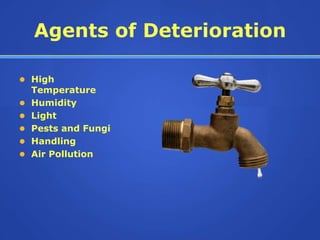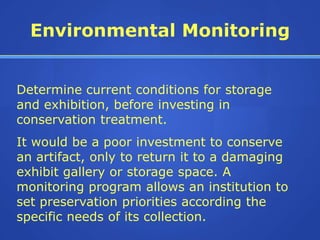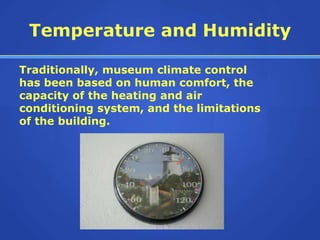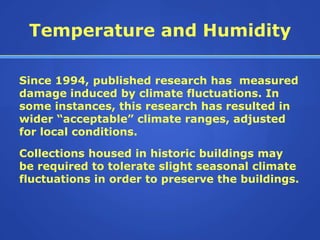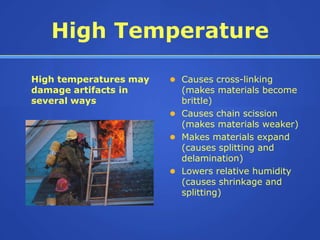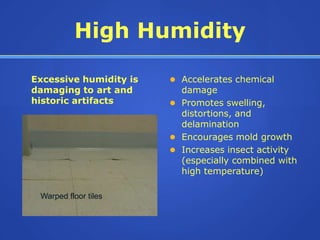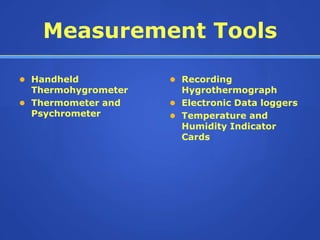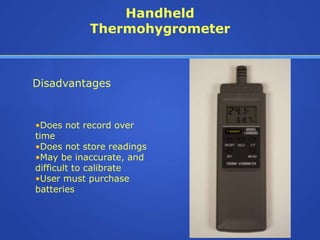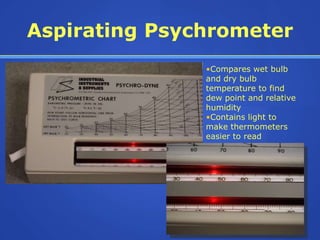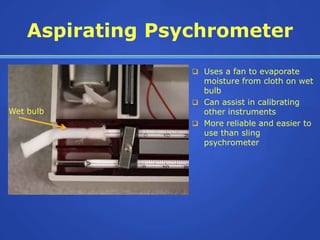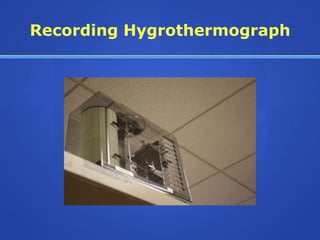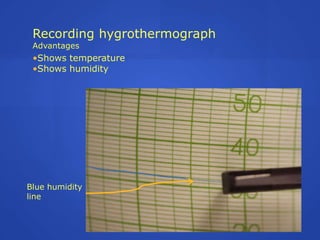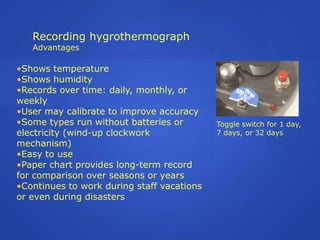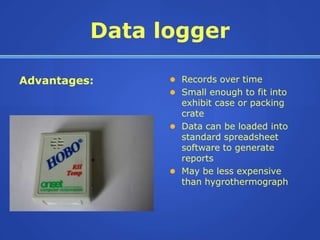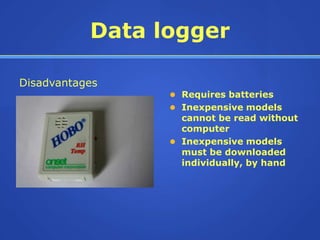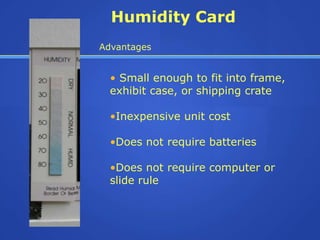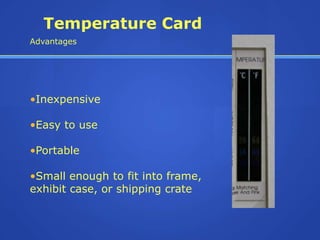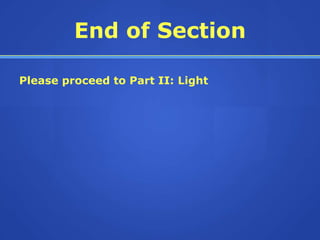Collection Care II: Temperature and Humidity
- 1. Collection Care: Environmental Factors Part I: Temperature and Humidity Valinda S. Carroll
- 2. Agents of Deterioration ’ü¼ High Temperature ’ü¼ Humidity ’ü¼ Light ’ü¼ Pests and Fungi ’ü¼ Handling ’ü¼ Air Pollution
- 3. Environmental Monitoring Determine current conditions for storage and exhibition, before investing in conservation treatment. It would be a poor investment to conserve an artifact, only to return it to a damaging exhibit gallery or storage space. A monitoring program allows an institution to set preservation priorities according the specific needs of its collection.
- 4. Temperature and Humidity Traditionally, museum climate control has been based on human comfort, the capacity of the heating and air conditioning system, and the limitations of the building.
- 5. Temperature and Humidity Since 1994, published research has measured damage induced by climate fluctuations. In some instances, this research has resulted in wider ŌĆ£acceptableŌĆØ climate ranges, adjusted for local conditions. Collections housed in historic buildings may be required to tolerate slight seasonal climate fluctuations in order to preserve the buildings.
- 6. High Temperature High temperatures may ’ü¼ Causes cross-linking damage artifacts in (makes materials become several ways brittle) ’ü¼ Causes chain scission (makes materials weaker) ’ü¼ Makes materials expand (causes splitting and delamination) ’ü¼ Lowers relative humidity (causes shrinkage and splitting)
- 7. Temperature and Humidity Relative humidity is directly affected by temperature, so the two factors should be monitored together. An increase in temperature results in a decrease in relative humidity, because warm air has the capacity to hold more water. As the temperature is reduced, relative humidity increases until it reaches 100%, and water condenses on surfaces. This temperature is called the ŌĆ£dew point.ŌĆØ Dehumidification is important to avoid condensation. A relative humidity range of 35% to 55% is safe for most types of collections, and allows moderate temperature variations.
- 8. High Humidity Excessive humidity is ’ü¼ Accelerates chemical damaging to art and damage historic artifacts ’ü¼ Promotes swelling, distortions, and delamination ’ü¼ Encourages mold growth ’ü¼ Increases insect activity (especially combined with high temperature) Warped floor tiles
- 9. Measurement Tools ’ü¼ Handheld ’ü¼ Recording Thermohygrometer Hygrothermograph ’ü¼ Thermometer and ’ü¼ Electronic Data loggers Psychrometer ’ü¼ Temperature and Humidity Indicator Cards
- 10. Handheld Thermohygrometer Advantages ŌĆóDisplays relative humidity ŌĆóDisplays temperature ŌĆóPortable ŌĆóEasy to use ŌĆóDoes not require additional equipment or supplies ŌĆóInexpensive
- 11. Handheld Thermohygrometer Disadvantages ŌĆóDoes not record over time ŌĆóDoes not store readings ŌĆóMay be inaccurate, and difficult to calibrate ŌĆóUser must purchase batteries
- 12. Aspirating Psychrometer ŌĆóCompares wet bulb and dry bulb temperature to find dew point and relative humidity ŌĆóContains light to make thermometers easier to read
- 13. Aspirating Psychrometer ’ü▒ Uses a fan to evaporate moisture from cloth on wet bulb ’ü▒ Can assist in calibrating Wet bulb other instruments ’ü▒ More reliable and easier to use than sling psychrometer
- 14. Aspirating Psychrometer ŌĆó Does not record over time ŌĆó Requires slide rule or mathematical calculations ŌĆó Does not generate documentation
- 15. Temperature and humidity guidelines from the psychrometer manual: The temperature range of 70-80F degrees for libraries and museums on this chart is aimed at human comfort rather than collection care.
- 17. Recording hygrothermograph Advantages ŌĆóShows temperature Red temperature line
- 18. Recording hygrothermograph Advantages ŌĆóShows temperature ŌĆóShows humidity Blue humidity line
- 19. Recording hygrothermograph Advantages ŌĆóShows temperature ŌĆóShows humidity ŌĆóRecords over time: daily, monthly, or weekly ŌĆóUser may calibrate to improve accuracy ŌĆóSome types run without batteries or Toggle switch for 1 day, electricity (wind-up clockwork 7 days, or 32 days mechanism) ŌĆóEasy to use ŌĆóPaper chart provides long-term record for comparison over seasons or years ŌĆóContinues to work during staff vacations or even during disasters
- 20. Recording hygrothermograph Disadvantages ŌĆóMay require regular winding or battery replacement ŌĆóUser must purchase paper charts and replacement pens ŌĆóExpensive ŌĆóPaper charts require storage space ŌĆóRed and blue ink lines may be faint and difficult to see ŌĆóCannot shift between Fahrenheit and Celsius, nor show dew point, etc. ŌĆóCannot be included in computer-generated reports and presentations
- 21. Data logger Advantages: ’ü¼ Records over time ’ü¼ Small enough to fit into exhibit case or packing crate ’ü¼ Data can be loaded into standard spreadsheet software to generate reports ’ü¼ May be less expensive than hygrothermograph
- 22. Data logger Disadvantages ’ü¼ Requires batteries ’ü¼ Inexpensive models cannot be read without computer ’ü¼ Inexpensive models must be downloaded individually, by hand
- 23. Humidity Card Advantages ŌĆó Small enough to fit into frame, exhibit case, or shipping crate ŌĆóInexpensive unit cost ŌĆóDoes not require batteries ŌĆóDoes not require computer or slide rule
- 24. Humidity Card Disadvantages ŌĆó Imprecise ŌĆóNot durable ŌĆóDoes not record over time ŌĆóCobalt blue salt is toxic (orange humidity cards are non-toxic)
- 25. Temperature Card Advantages ŌĆóInexpensive ŌĆóEasy to use ŌĆóPortable ŌĆóSmall enough to fit into frame, exhibit case, or shipping crate
- 26. Temperature Card Disadvantages ŌĆóImprecise ŌĆóDoes not record over time ŌĆóDoes not generate permanent documentation ŌĆóNot durable
- 27. End of Section Please proceed to Part II: Light


